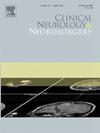Risk factors for acute symptomatic seizure in children with cerebral sinovenous thrombosis: Experience from a tertiary center
IF 1.8
4区 医学
Q3 CLINICAL NEUROLOGY
引用次数: 0
Abstract
Objective
To investigate the risk factors for acute symptomatic seizure (ASS) in children with Cerebral Sinovenous Thrombosis (CSVT) and to evaluate the effect of ASS on outcome.
Methods
Cross-sectional, single-center, hospital-based retrospective analysis of 42 children with neuroimaging-confirmed CSVT recorded between December 2009 and January 2023. ASS was defined as a seizure occurring within 7 days after CSVT. Predictors for ASS were analyzed by univariate and multivariate logistic regression. Functional outcomes were evaluated using the Pediatric Stroke Outcome Measure (PSOM).
Results
The average age of the 42 patients included in the study sample was 105.36 ± 63.1 months. Almost one-third (28.6 %) of patients with CSVT developed ASS. In univariate analysis, factors associated with seizure risk were young age, low Glasgow Coma Scale at admission, long hospital stay, headache, change of consciousness, focal neurological findings, cerebral hemorrhage, motor deficit and high D-dimer level (p=0.018, p<0.001, p= 0.016, p= 0.001, p=0.014, p<0.001, p<0.001, p=0.019 and p=0.013, respectively). In multivariate analysis young age, focal neurological findings and D-dimer levels were potential predictors of ASS (p=0.004, p=0.003, p=0.036, respectively). Receiver operating characteristic (ROC) analysis for D-dimer diagnostic accuracy in patients with CSVT revealed D-dimer > 498 ng/mL (AUC=0.743). In both cohorts, PSOM scores at last follow-up were worse in those with acute seizures compared to those without (p<0.001).
Conclusion
Acute seizures occurred in approximately one-third of our cohort. Young age, focal neurological findings, and high D-dimer levels are potential predictors of ASS in children. Children with ASS had worse outcomes than those without.
脑静脉血栓儿童急性症状性癫痫发作的风险因素:一家三级医疗中心的经验
方法对2009年12月至2023年1月期间记录的42例神经影像学确诊的CSVT患儿进行横断面、单中心、基于医院的回顾性分析。ASS定义为CSVT后7天内发生的癫痫发作。通过单变量和多变量逻辑回归分析了ASS的预测因素。研究结果研究样本中的42名患者的平均年龄为(105.36 ± 63.1)个月。近三分之一(28.6%)的CSVT患者发展为ASS。在单变量分析中,与癫痫发作风险相关的因素有年轻、入院时格拉斯哥昏迷量表低、住院时间长、头痛、意识改变、局灶性神经系统检查结果、脑出血、运动障碍和高 D-二聚体水平(分别为 p=0.018、p<0.001、p=0.016、p=0.001、p=0.014、p<0.001、p<0.001、p=0.019 和 p=0.013)。在多变量分析中,年轻年龄、局灶性神经系统检查结果和 D-二聚体水平是 ASS 的潜在预测因素(分别为 p=0.004、p=0.003 和 p=0.036)。CSVT患者D-二聚体诊断准确性的接收者操作特征(ROC)分析显示,D-二聚体为498纳克/毫升(AUC=0.743)。在两组患者中,与无急性发作的患者相比,有急性发作的患者在最后一次随访时的 PSOM 评分更差(p<0.001)。年龄小、局灶性神经系统检查结果和高 D-二聚体水平是儿童 ASS 的潜在预测因素。患 ASS 的儿童比未患 ASS 的儿童的预后更差。
本文章由计算机程序翻译,如有差异,请以英文原文为准。
求助全文
约1分钟内获得全文
求助全文
来源期刊

Clinical Neurology and Neurosurgery
医学-临床神经学
CiteScore
3.70
自引率
5.30%
发文量
358
审稿时长
46 days
期刊介绍:
Clinical Neurology and Neurosurgery is devoted to publishing papers and reports on the clinical aspects of neurology and neurosurgery. It is an international forum for papers of high scientific standard that are of interest to Neurologists and Neurosurgeons world-wide.
 求助内容:
求助内容: 应助结果提醒方式:
应助结果提醒方式:


